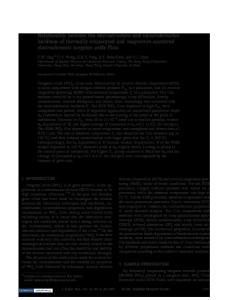Correlation Between the Mechanical Stress and Microstructure in Reactive Bias Magnetron Sputtered Silicon Nitride Films
- PDF / 1,976,535 Bytes
- 6 Pages / 414.72 x 648 pts Page_size
- 53 Downloads / 336 Views
ABSTRACT The influence of ion bombardment on the mechanical stress and microstructure of sputtered silicon nitride (SiNs) films has been systematically investigated. Applied substrate bias voltage was used to control the bombardment energy in a radio frequency (rf) reactive magnetron sputtering system. The resultant films were characterized by transmission electron microscopy (TEM), atomic force microscopy (AFM), Fourier transform infrared spectroscopy (FT-IR), Rutherford backscattering spectrometry (RBS), stress and chemical etch rate measurements. As the bias voltage was increased, the internal stress in SiNg films became increasingly compressive and reached a value of about 18.3 X 10 9 dyne/cm 2 at higher bias voltages. These correlated well with the transition of the film microstructure from a porous microcolumnar structure containing large void to the more densely packed one. The obtained results can be explained in terms of atomic peening by energetic particles, leading to densification of the microstructure. It was also found that the amount of argon incorporated in the film is increased with increasing bias voltage, whereas the oxygen content is decreased. The lowest etch rate in buffered HF solution, approximately 1.2 A/sec, was observed with the application of a substrate bias of -50 V.
INTRODUCTION Silicon nitride films are now widely used in the microelectronic devices fabrication such as gate dielectrics, interlevel insulators, and final passivation layers. This is a consequence of the attractive features of these films such as a high thermal stability, chemical inertness, extreme hardness, and good dielectric properties. Silicon nitride films are mainly produced by plasmaenhanced chemical vapor depositon (PECVD) using the glow discharge decomposition of a SiH 4 and NH 3 gas mixture as the most common source gases. However, it has been well known that the films produced in this way often contain large amounts of bonded hydrogen (10-30 at.%) in the form of NH and Si-H bonding groups, which occasionally causes the degradation of device characteristics.' As the reactive sputtering has mostly N2 and Ar in the chamber, it is very attractive for obtaining hydrogen-free silicon nitride films. Reactively sputtered silicon nitride films have been successfully used as the gate dielectric material for the fabrication of metal-insulator-semiconductor field effect transistor (MISFET), passivation layers to protect GaAs metal-semiconductor FET (MESFET) and high electron mobility transistor (HEMT) devices, as well as an encapsulant for annealing an ionimplanted GaAs.2,3 In this study, silicon nitride films have been deposited by reactive magnetron sputtering of a silicon target in N2-Ar atmosphere. The influence of ion bombardment of the growing surface on the mechanical stress and microstructure of these films has been systematically investigated using TEM, AFM, RBS, FT-IR, stress and chemical etch rate measurements.
EXPERIMENT The target was ultra-high-purity (99.99999%) silicon disc. The distance between the tar
Data Loading...







